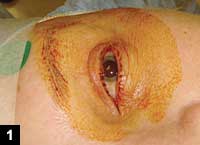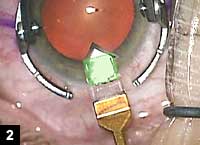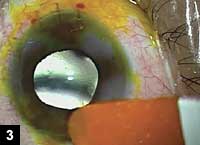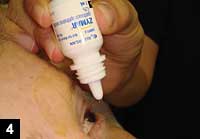Endophthalmitis prevention demands multi-step approach
Surgeons should take into account preoperative conditions, intraoperative surgical techniques and postoperative instructions.

There are nearly 3 million cataract surgeries performed in the United States per year. Even though the risk of endophthalmitis is low, it is still a problem that affects thousands of our patients annually. There are steps that we can take to help prevent this devastating complication and make surgery safer for our patients.
Preoperative considerations
 Uday Devgan |
Pre-existing ocular surface disease and eyelid inflammatory conditions can weaken the immune defenses of the tear film and expose the eye to additional bacterial flora. Appropriately treating blepharitis, meibomian gland disease and tear film dysfunction is important to rehabilitate the ocular surface before surgery.
Pre-treatment with topical fluoroquinolone antibiotics is highly recommended before and after surgery. There is evidence that use of a fourth-generation fluoroquinolone with the added anti-bacterial effects of the benzalkonium chloride preservative can provide a fast bacterial kill time and a full spectrum of antimicrobial coverage. For this reason, I use Zymar (gatifloxacin, Allergan) 3 days before surgery and 7 days after surgery.
Perhaps the most important step before surgery is antisepsis of the eyelids and ocular surface with the application of povidone iodine, 10% solution to the skin and 5% solution in the conjunctival cul-de-sac. This provides a rapid reduction in the preoperative bacterial count and helps to lessen the quantity of microbes that are introduced into the eye during surgery. Draping the eyelashes out of the way helps to separate the natural flora of the eyelids from the surgical field.
Intraoperative techniques
A leaking surgical incision can allow microbes of the ocular surface to penetrate the anterior chamber and cause endophthalmitis and subsequent visual loss. With some reports of an increased risk of endophthalmitis with clear corneal incisions as compared with scleral tunnels, a closer look at the issue is warranted. OSN Cataract Surgery Section Member I. Howard Fine, MD, has shown that the architecture, location and integrity of a clear corneal incision are all vital to its sealing ability.
A properly constructed clear corneal incision should be more square than rectangular and should be cleanly cut without evidence of jaggedness or irregularity. This means that the tunnel length of the clear corneal incision should be about the same dimension as the width of the incision: a 2.5-mm-wide corneal incision should be about 2.5 mm in tunnel length before penetrating Descemet’s layer. Diamond knives are many times sharper than steel knives, and they tend to produce a smoother incision. In addition, nicking the limbal vessels while making the incision can help to speed healing and make for a stronger wound in the postoperative period.
During the surgery, care must be taken to avoid damaging the incision. Stretching an incision, such as during IOL insertion, often leads to ripping of the edges, whereas slightly enlarging an incision produces a better result. An improperly oriented phaco probe can cause a Descemet’s detachment when inserted through the clear corneal incision. This focal loss weakens the natural endothelial cell pump function, and the incision is not likely to seal as well.
Corneal stromal hydration is a good adjunctive technique to further seal an already correctly created incision. Be aware that the effect of the stromal hydration is short-lived, often only a few hours, and it is not a substitute for a suture for a leaky incision. The IOP at the end of the case should be returned to a physiologic or somewhat supra-physiologic level, and the incision should be checked for leakage with the use of a microsurgical sponge. Note that all incisions should be checked, including the paracentesis, which is often a source of leakage.
If there is any question as to the integrity of the incision, it can be checked for leakage with the Seidel fluorescein dye test. Any evidence of leakage should be addressed with a suture, typically 10-0 nylon or 10-0 Vicryl. It is far easier to place a suture on the day of surgery while still in the operating room than afterward in the clinic.
A complicated cataract case, particularly if there is a broken posterior capsule or vitreous loss, poses a higher risk of infection after surgery. These patients should have their incisions sutured, and the surgeon should consider intracameral and local antibiotics.
|
|
|
|
|
Images: Devgan U |
Postoperative period
During the 24 hours after surgery, the patient must avoid rubbing or even touching the operated eye because pressure near the incision can cause it to leak. An incision that leaks can draw microbes from the tear film into the eye and cause endophthalmitis. Patients must be instructed how to gently instill their postoperative topical medications and must wash their hands before using any eye drops. The use of topical antibiotics should begin immediately after surgery and continue for at least a few days. Again, my preference is to use a fourth-generation fluoroquinolone, gatifloxacin, with a fast kill time so that the ocular surface has a greatly reduced bacterial level.
The patients should be instructed that if they experience the cardinal symptoms of endophthalmitis, pain and decreased vision, they should contact the surgeon immediately. If there is any suspicion on the part of the cataract surgeon, the diagnostic and treatment regimens should be initiated immediately, often with the help of a vitreoretinal colleague.
Endophthalmitis can be a devastating complication after a beautifully performed cataract surgery. We need to stack the odds in our favor by implementing a multi-step approach to decrease the risks, thereby providing a safer surgery for our patients.
For more information:
- Uday Devgan, MD, FACS, is in private practice at Devgan Eye Surgery in Los Angeles, Beverly Hills, and Newport Beach, California. Dr. Devgan is Chief of Ophthalmology at Olive View UCLA Medical Center and an Associate Clinical Professor at the Jules Stein Eye Institute at the UCLA School of Medicine. Dr. Devgan can be reached at 11600 Wilshire Blvd., Suite 200, Los Angeles, CA 90025; 800-337-1969; fax: 310-388-3028; e-mail: devgan@gmail.com; Web site: www.DevganEye.com. Dr.Devgan is a consultant to Abbott Medical Optics and Bausch & Lomb, and is a stockholder in Alcon Laboratories and formerly in Advanced Medical Optics.
References:
- Apt L, Isenberg SJ. Infectious endophthalmitis after cataract surgery. Br J Ophthalmol. 1994;78(12):948-949.
- Blondeau JM, Borsos S, Hesje CK. Antimicrobial efficacy of gatifloxacin and moxifloxacin with and without benzalkonium chloride compared with ciprofloxacin and levofloxacin against methicillin-resistant Staphylococcus aureus. J Chemother. 2007;19(2):146-151.
- Ernest PH. Corneal incision architecture. Lecture presented at: American Academy of Ophthalmology meeting; November 2007; New Orleans.
- Fine IH, Hoffman RS, Packer M. Profile of clear corneal cataract incisions demonstrated by ocular coherence tomography. J Cataract Refract Surg. 2007;33(1):94-97.
- Kowalski RP, Kowalski BR, et al. The in vitro impact of moxifloxacin and gatifloxacin concentration (0.5% vs 0.3%) and the addition of benzalkonium chloride on antibacterial efficacy. Am J Ophthalmol. 2006;142(5):730-735.
- Taban M, Sarayba MA, et al. Ingress of India ink into the anterior chamber through sutureless clear corneal cataract wounds. Arch Ophthalmol. 2005;123(5):643-648.




